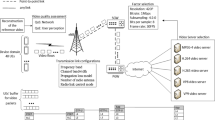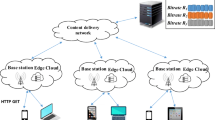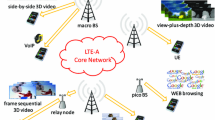Abstract
Video streaming on mobile devices necessitates a balance between Quality of Experience (QoE) and energy consumption. Given large data sizes from video, extensive amounts of battery power are required for downloading, processing, and playing each video segment. However, video quality may suffer drastically in an effort to pursue energy efficiency. In balancing these two objectives, our research incorporates advanced energy models, processor clock rates, buffer management, and network quality aware downloading. Furthermore, multi-user systems present unique challenges because the availability of network resources can vary greatly over time. We introduce an algorithm that accounts for these fluctuations and effectively balances QoE and energy consumption. Present application in LTE networks and foundations for future implementation in 5G systems are provided. We provide comparison of the performance of our algorithm with an optimal solution and show superior performance against state-of-the-art DASH-inspired algorithms. Finally, we show our algorithm gains in both QoE and energy metrics across users in large-scale multi-cell scenarios.








Similar content being viewed by others
Notes
LG Nexus 5x Cortex-A57 is typically turned off during video streaming.
Assuming all phones operate at the same discrete CPU frequencies.
Specifically, QoE research participants were given a discrete 9-level rating scale, which was then averaged across users and transformed into the standard \(MOS_5\) rating range assuming continuous values between 1 and 5 [10]. Experimental values for rebuffering and resolution decrease impacts [41, 42] are derived using this \(MOS_5\) range.
The impact of vibration, \(I_{u,i}^{vib}\), has been removed from the QoE equation to restrict scope.
See Table 4 for explicit values.
Notation: \(\lceil x\rceil = \) an integer satisfying \(\lceil x \rceil - 1 < x \le \lceil x \rceil\).
An equivalent alternate formulation would invert the QoE and Energy signs and solve for the maximum, meaning QoE minus energy consumption.
References
Wheatman, K., Mehmeti, F., Mahon, M., La Porta, T., & Cao, G. (2020). Multi-user competitive energy-aware and qoe-aware video streaming on mobile devices. In Proceedings of the 16th ACM symposium on QoS and security for wireless and mobile networks (pp. 47–55).
Cisco Annual Internet Report (2018-2023) White Paper. http://goo.gl/DXWFyr
Bentaleb, A., Taani, B., Begen, A. C., Timmerer, C., & Zimmermann, R. (2018). A survey on bitrate adaptation schemes for streaming media over http. IEEE Communications Surveys & Tutorials, 21(1), 562–585.
Irondi, I., Wang, Q., Grecos, C., Calero, J. M. A., & Casaseca-De-La-Higuera, P. (2019). Efficient qoe-aware scheme for video quality switching operations in dynamic adaptive streaming. ACM Transactions on Multimedia Computing, Communications, and Applications. https://doi.org/10.1145/3269494.
Jabbar, S., Kadhim, D., & Li, Y. (2018). Improving video quality in dash systems by proposing adaptive bitrate scheme based on variable segment size approach. International Journal of Computer Applications, 180, 13–18. https://doi.org/10.5120/ijca2018916416.
Zhuo, J., & Chakrabarti, C. (2008). Energy-efficient dynamic task scheduling algorithms for dvs systems. ACM Transactions on Embedded Computing Systems. https://doi.org/10.1145/1331331.1331341.
Mpeg, I. (2012). Information technology-dynamic adaptive streaming over http (dash)-part 1: Media presentation description and segment formats. ISO/IEC MPEG: Tech. Rep.
Sani, Y., Mauthe, A., & Edwards, C. (2017). Adaptive bitrate selection: A survey. IEEE Communications Surveys & Tutorials, 19(4), 2985–3014.
Chen, X., Tan, T., & Cao, G. (2019). Energy-aware and context-aware video streaming on smartphones. In 2019 IEEE 39th international conference on distributed computing systems (ICDCS) (pp. 861–870).
Chen, X., Tan, T., Cao, G., & La Porta, T. F. (2020). Context-aware and energy-aware video streaming on smartphones. IEEE Transactions on Mobile Computing.
Yang, Y., Hu, W., Chen, X., & Cao, G. (2019). Energy-aware cpu frequency scaling for mobile video streaming. IEEE Transactions on Mobile Computing, 18(11), 2536–2548.
Choi, W., & Yoon, J. (2019). Sate: Providing stable and agile adaptation in http-based video streaming. IEEE Access, 7, 26830–26841.
Huang, T.-Y., Johari, R., McKeown, N., Trunnell, M., & Watson, M. (2014). A buffer-based approach to rate adaptation: Evidence from a large video streaming service. SIGCOMM Computer Communication Review, 44(4), 187–198. https://doi.org/10.1145/2740070.2626296.
Ketykó, I., Moor, K. D., De Pessemier, T., Verdejo, A. J., Vanhecke, K., Joseph, W., Martens, L., & Marez, L. D. (2010). Qoe measurement of mobile youtube video streaming. In Proceedings of the 3rd workshop on mobile video delivery (pp. 27–32).
Hu, W., & Cao, G. (2015). Energy-aware video streaming on smartphones. In Proceedings of IEEE conference on computer communications (INFOCOM).
Yan, M., Chan, C. A., Gygax, A. F., Yan, J., Campbell, L., Nirmalathas, A., & Leckie, C. (2019). Modeling the total energy consumption of mobile network services and applications. Energies, 12(1), 184.
Balasubramanian, N., Balasubramanian, A., & Venkataramani, A. (2009). Energy consumption in mobile phones: A measurement study and implications for network applications. In Proceedings of 9th conference on internet measurement (IMC). ACM SIGCOMM, New York, NY. https://doi.org/10.1145/1644893.1644927
Cui, Y., Xiao, S., Wang, X., Li, M., Wang, H., & Lai, Z. (2014). Performance-aware energy optimization on mobile devices in cellular network. In Proceedings of IEEE conference on computer communications (INFOCOM) (pp. 1123–1131).
Qian, F., Wang, Z., Gerber, A., Mao, Z. M., Sen, S., & Spatscheck, O. (2010). Top: Tail optimization protocol for cellular radio resource allocation. In The 18th IEEE international conference on network protocols (pp. 285–294).
Dasari, M., Vargas, S., Bhattacharya, A., Balasubramanian, A., Das, S. R., & Ferdman, M. (2018). Impact of device performance on mobile internet qoe. In Proceedings of 2018 internet measurement conference IMC ’18 (pp. 1–7). ACM, New York, NY, USA. https://doi.org/10.1145/3278532.3278533
Kwon, K., Chae, S., & Woo, K. (2013). An application-level energy-efficient scheduling for dynamic voltage and frequency scaling. In 2013 IEEE international conference on consumer electronics (ICCE) (pp. 3–6).
Pillai, P., & Shin, K. G. (2001). Real-time dynamic voltage scaling for low-power embedded operating systems. In Proceedings of the eighteenth ACM symposium on operating systems principles. SOSP ’01 (pp. 89–102). ACM, New York, NY, USA. https://doi.org/10.1145/502034.502044
Spiteri, K., Sitaraman, R., & Sparacio, D. (2019). From theory to practice: Improving bitrate adaptation in the dash reference player. ACM Transactions on Multimedia Computing, Communications, and Applications (TOMM), 15(2s), 1–29.
Ul Mustafa, R., Ferlin, S., Esteve Rothenberg, C., Raca, D., & J. Quinlan, J. (2020). A supervised machine learning approach for dash video qoe prediction in 5g networks. In Proceedings of the 16th ACM symposium on qos and security for wireless and mobile networks (pp. 57–64).
Abar, T., Letaifa, A. B., & Elasmi, S. (2018). Enhancing qoe based on machine learning and dash in sdn networks. In 2018 32nd international conference on advanced information networking and applications workshops (WAINA) (pp. 258–263). IEEE.
Abar, T., Ben Letaifa, A., & El Asmi, S. (2020). Heterogeneous multiuser qoe enhancement over dash in sdn networks. Wireless Personal Communications, 114(4), 2975–3001.
Rothenberg, C. E., Perez, D. A. L., de Sousa, N. F. S., Rosa, R. V., Mustafa, R. U., Islam, M. T., & Gomes, P. H. (2020). Intent-based control loop for dash video service assurance using ml-based edge qoe estimation. In 2020 6th IEEE conference on network softwarization (NetSoft) (pp. 353–355). IEEE.
Amour, L., Mushtaq, M. S., Souihi, S., & Mellouk, A. (2017). Qoe-based framework to optimize user perceived video quality. In 2017 IEEE 42nd conference on local computer networks (LCN) (pp. 599–602). IEEE.
Ben Letaifa, A. (2018). Real time ml-based qoe adaptive approach in sdn context for http video services. Wireless Personal Communications, 103(3), 2633–2656.
Nightingale, J., Salva-Garcia, P., Calero, J. M. A., & Wang, Q. (2018). 5g-qoe: Qoe modelling for ultra-hd video streaming in 5g networks. IEEE Transactions on Broadcasting, 64(2), 621–634.
Vo, N.-S., Duong, T. Q., Tuan, H. D., & Kortun, A. (2017). Optimal video streaming in dense 5g networks with d2d communications. IEEE Access, 6, 209–223.
Tuysuz, M. F., & Aydin, M. E. (2020). Qoe-based mobility-aware collaborative video streaming on the edge of 5g. IEEE Transactions on Industrial Informatics, 16(11), 7115–7125.
Sun, L., Duanmu, F., Liu, Y., Wang, Y., Ye, Y., Shi, H., & Dai, D. (2018). Multi-path multi-tier 360-degree video streaming in 5g networks. In Proceedings of the 9th ACM multimedia systems conference (pp. 162–173).
Qiao, J., He, Y., & Shen, X. S. (2016). Proactive caching for mobile video streaming in millimeter wave 5g networks. IEEE Transactions on Wireless Communications, 15(10), 7187–7198.
Bilal, K., & Erbad, A. (2017). Edge computing for interactive media and video streaming. In 2017 second international conference on fog and mobile edge computing (FMEC) (pp. 68–73). IEEE.
Wang, D., Peng, Y., Ma, X., Ding, W., Jiang, H., Chen, F., & Liu, J. (2018). Adaptive wireless video streaming based on edge computing: Opportunities and approaches. IEEE Transactions on services Computing, 12(5), 685–697.
Mehrabi, A., Siekkinen, M., & Ylä-Jääski, A. (2018). Edge computing assisted adaptive mobile video streaming. IEEE Transactions on Mobile Computing, 18(4), 787–800.
Jiang, X., Yu, F. R., Song, T., & Leung, V. C. (2021). A survey on multi-access edge computing applied to video streaming: Some research issues and challenges. IEEE Communications Surveys & Tutorials, 23(2), 871–903.
Mittal, R., Kansal, A., & Chandra, R. (2012). Empowering developers to estimate app energy consumption. In Proceedings of the 18th annual international conference on mobile computing and networking. Mobicom ’12 (pp. 317–328). ACM, New York, NY, USA. https://doi.org/10.1145/2348543.2348583
Kwak, J., Choi, O., Chong, S., & Mohapatra, P. (2014). Dynamic speed scaling for energy minimization in delay-tolerant smartphone applications, pp. 2292–2300. https://doi.org/10.1109/INFOCOM.2014.6848173
Mok, R. K., Chan, E. W., & Chang, R. K. (2011). Measuring the quality of experience of http video streaming. In 12th IFIP/IEEE international symposium on integrated network management (IM 2011) and workshops (pp. 485–492). IEEE.
Miller, K., Bethanabhotla, D., Caire, G., & Wolisz, A. (2015). A control-theoretic approach to adaptive video streaming in dense wireless networks. IEEE Transactions on Multimedia, 17(8), 1309–1322.
Yin, X., Jindal, A., Sekar, V., & Sinopoli, B. (2015). A control-theoretic approach for dynamic adaptive video streaming over http. In Proceedings of 2015 ACM conference on special interest group on data communication (SIGCOMM) (pp. 325–338). ACM, New York, NY, USA. https://doi.org/10.1145/2785956.2787486
Sahinidis, N. V. (2019). Optimization and engineering (pp. 301–306). Springer. https://doi.org/10.1007/s11081-019-09438-1.
Dubin, R., Hadar, O., & Dvir, A. (2013). The effect of client buffer and mbr consideration on dash adaptation logic. In 2013 IEEE wireless communications and networking conference (WCNC) (pp. 2178–2183). IEEE.
Cho, K., Mitsuya, K., & Kato, A. (2000). Traffic data repository at the wide project. In Proceedings of USENIX 2000 annual technical conference: FREENIX Track (pp. 263–270).
Mehmeti, F., & Rosenberg, C. (2019). How expensive is consistency? Performance analysis of consistent rate provisioning to mobile users in cellular networks. IEEE Transactions on Mobile Computing, 18(5), 1098–115.
Rebekka, B., Sudheep, S., & Malarkodi, B. (2015). An optimal and priority based rate guaranteed radio resource allocation scheme for lte downlink. Wireless Personal Communications, 83(3), 1643–1661. https://doi.org/10.1007/s11277-015-2468-1.
Cox, C. (2012). An Introduction to LTE: LTE, LTE-advanced, SAE and 4G Mobile Communications. Wiley.
Mamman, M., Hanapi, Z. M., Abdullah, A., & Muhammed, A. (2019). Quality of service class identifier (qci) radio resource allocation algorithm for lte downlink. PLOS one, 14(1), e0210310.
3GPP: Lte; evolved universal terrestrial radio access (e-utra); requirements for support of radio resource management. Technical Specification (TS) 36.133, 3rd Generation Partnership Project (3GPP) (2010). Version 8.9.0. https://www.3gpp.org/dynareport/36133.htm
Kawser, M. T., Hamid, B., Hasan, N., Alam, M. S., & Rahman, M. M. (2012). Downlink snr to cqi mapping for different multiple antenna techniques in lte. International Journal of Electronics and Information Engineering, 2(5), 757–760.
Spiteri, K., Urgaonkar, R., & Sitaraman, R. K. (2020). Bola: Near-optimal bitrate adaptation for online videos. IEEE/ACM Transactions on Networking, 28(4), 1698–1711.
Funding
Research was sponsored by the National Science Foundation (NSF) under grant number CNS-1815465. The datasets generated during and analysed during the current study are available from the corresponding author on reasonable request.
Author information
Authors and Affiliations
Corresponding author
Additional information
Publisher's Note
Springer Nature remains neutral with regard to jurisdictional claims in published maps and institutional affiliations.
Initial results of this paper have been presented at the ACM Symposium on QoS and Security for Wireless and Mobile Networks (Q2SWinet), 2020 [1].
Rights and permissions
Springer Nature or its licensor (e.g. a society or other partner) holds exclusive rights to this article under a publishing agreement with the author(s) or other rightsholder(s); author self-archiving of the accepted manuscript version of this article is solely governed by the terms of such publishing agreement and applicable law.
About this article
Cite this article
Wheatman, K., Mehmeti, F., Mahon, M. et al. EQMS: An improved energy-aware and QoE-aware video streaming policy across multiple competitive mobile devices. Wireless Netw 29, 1465–1484 (2023). https://doi.org/10.1007/s11276-022-03199-z
Accepted:
Published:
Issue Date:
DOI: https://doi.org/10.1007/s11276-022-03199-z




